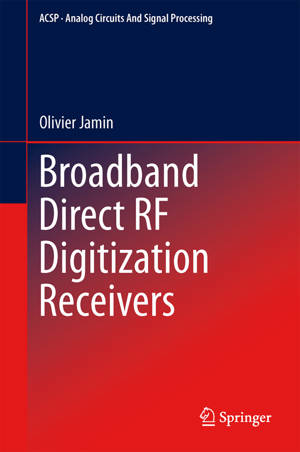
- Afhalen na 1 uur in een winkel met voorraad
- Gratis thuislevering in België vanaf € 30
- Ruim aanbod met 7 miljoen producten
- Afhalen na 1 uur in een winkel met voorraad
- Gratis thuislevering in België vanaf € 30
- Ruim aanbod met 7 miljoen producten
Zoeken
Omschrijving
This book discusses the trade-offs involved in designing direct RF digitization receivers for the radio frequency and digital signal processing domains. A system-level framework is developed, quantifying the relevant impairments of the signal processing chain, through a comprehensive system-level analysis. Special focus is given to noise analysis (thermal noise, quantization noise, saturation noise, signal-dependent noise), broadband non-linear distortion analysis, including the impact of the sampling strategy (low-pass, band-pass), analysis of time-interleaved ADC channel mismatches, sampling clock purity and digital channel selection. The system-level framework described is applied to the design of a cable multi-channel RF direct digitization receiver. An optimum RF signal conditioning, and some algorithms (automatic gain control loop, RF front-end amplitude equalization control loop) are used to relax the requirements of a 2.7GHz 11-bit ADC.
A two-chip implementation is presented, using BiCMOS and 65nm CMOS processes, together with the block and system-level measurement results. Readers will benefit from the techniques presented, which are highly competitive, both in terms of cost and RF performance, while drastically reducing power consumption.
A two-chip implementation is presented, using BiCMOS and 65nm CMOS processes, together with the block and system-level measurement results. Readers will benefit from the techniques presented, which are highly competitive, both in terms of cost and RF performance, while drastically reducing power consumption.
Specificaties
Betrokkenen
- Auteur(s):
- Uitgeverij:
Inhoud
- Aantal bladzijden:
- 162
- Taal:
- Engels
- Reeks:
- Reeksnummer:
- nr. 121
Eigenschappen
- Productcode (EAN):
- 9783319011493
- Verschijningsdatum:
- 19/09/2013
- Uitvoering:
- Hardcover
- Formaat:
- Genaaid
- Afmetingen:
- 157 mm x 234 mm
- Gewicht:
- 476 g

Alleen bij Standaard Boekhandel
+ 210 punten op je klantenkaart van Standaard Boekhandel
Beoordelingen
We publiceren alleen reviews die voldoen aan de voorwaarden voor reviews. Bekijk onze voorwaarden voor reviews.











